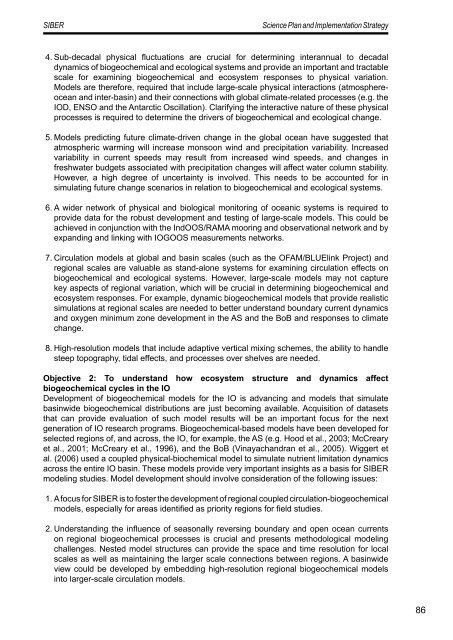SIBER SPIS sept 2011.pdf - IMBER
SIBER SPIS sept 2011.pdf - IMBER
SIBER SPIS sept 2011.pdf - IMBER
You also want an ePaper? Increase the reach of your titles
YUMPU automatically turns print PDFs into web optimized ePapers that Google loves.
<strong>SIBER</strong><br />
Science Plan and Implementation Strategy<br />
4. Sub-decadal physical fluctuations are crucial for determining interannual to decadal<br />
dynamics of biogeochemical and ecological systems and provide an important and tractable<br />
scale for examining biogeochemical and ecosystem responses to physical variation.<br />
Models are therefore, required that include large-scale physical interactions (atmosphereocean<br />
and inter-basin) and their connections with global climate-related processes (e.g. the<br />
IOD, ENSO and the Antarctic Oscillation). Clarifying the interactive nature of these physical<br />
processes is required to determine the drivers of biogeochemical and ecological change.<br />
5. Models predicting future climate-driven change in the global ocean have suggested that<br />
atmospheric warming will increase monsoon wind and precipitation variability. Increased<br />
variability in current speeds may result from increased wind speeds, and changes in<br />
freshwater budgets associated with precipitation changes will affect water column stability.<br />
However, a high degree of uncertainty is involved. This needs to be accounted for in<br />
simulating future change scenarios in relation to biogeochemical and ecological systems.<br />
6. A wider network of physical and biological monitoring of oceanic systems is required to<br />
provide data for the robust development and testing of large-scale models. This could be<br />
achieved in conjunction with the IndOOS/RAMA mooring and observational network and by<br />
expanding and linking with IOGOOS measurements networks.<br />
7. Circulation models at global and basin scales (such as the OFAM/BLUElink Project) and<br />
regional scales are valuable as stand-alone systems for examining circulation effects on<br />
biogeochemical and ecological systems. However, large-scale models may not capture<br />
key aspects of regional variation, which will be crucial in determining biogeochemical and<br />
ecosystem responses. For example, dynamic biogeochemical models that provide realistic<br />
simulations at regional scales are needed to better understand boundary current dynamics<br />
and oxygen minimum zone development in the AS and the BoB and responses to climate<br />
change.<br />
8. High-resolution models that include adaptive vertical mixing schemes, the ability to handle<br />
steep topography, tidal effects, and processes over shelves are needed.<br />
Objective 2: To understand how ecosystem structure and dynamics affect<br />
biogeochemical cycles in the IO<br />
Development of biogeochemical models for the IO is advancing and models that simulate<br />
basinwide biogeochemical distributions are just becoming available. Acquisition of datasets<br />
that can provide evaluation of such model results will be an important focus for the next<br />
generation of IO research programs. Biogeochemical-based models have been developed for<br />
selected regions of, and across, the IO, for example, the AS (e.g. Hood et al., 2003; McCreary<br />
et al., 2001; McCreary et al., 1996), and the BoB (Vinayachandran et al., 2005). Wiggert et<br />
al. (2006) used a coupled physical-biochemical model to simulate nutrient limitation dynamics<br />
across the entire IO basin. These models provide very important insights as a basis for <strong>SIBER</strong><br />
modeling studies. Model development should involve consideration of the following issues:<br />
1. A focus for <strong>SIBER</strong> is to foster the development of regional coupled circulation-biogeochemical<br />
models, especially for areas identified as priority regions for field studies.<br />
2. Understanding the influence of seasonally reversing boundary and open ocean currents<br />
on regional biogeochemical processes is crucial and presents methodological modeling<br />
challenges. Nested model structures can provide the space and time resolution for local<br />
scales as well as maintaining the larger scale connections between regions. A basinwide<br />
view could be developed by embedding high-resolution regional biogeochemical models<br />
into larger-scale circulation models.<br />
86












